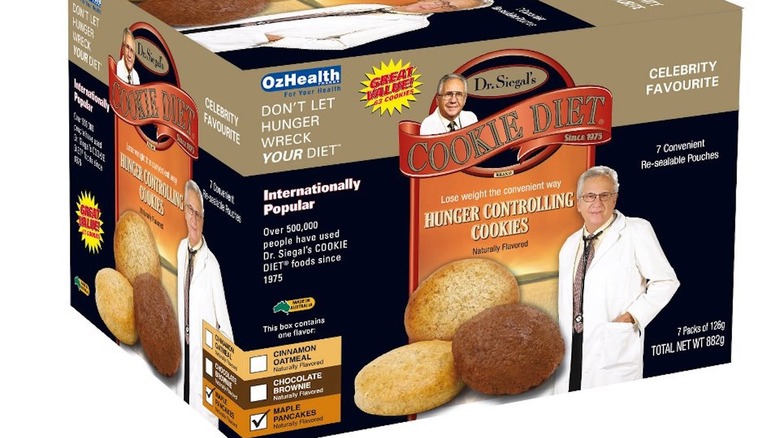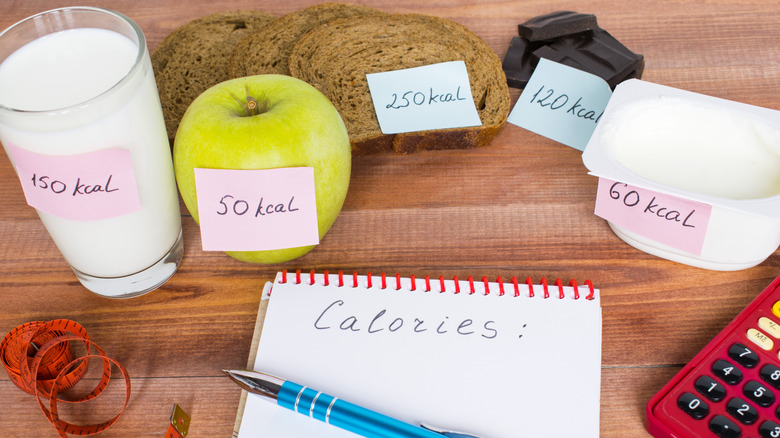This '70s Diet Required Followers To Eat Cookies
There is certainly no shortage of weight loss advice floating around, and while some of it may be useful and very sound advice, there are also plenty of fad diets and quick fixes that promise weight loss without the hassle. And this certainly isn't a new phenomenon. From the cabbage soup diet to the baby food diet, for decades people have been trying almost anything to find quick and easy ways to lose weight. But few have had a more appealing name than the "Cookie Diet," a weight loss program developed in the 1970s that claimed to help people shed unwanted pounds through eating specialty cookies that had appetite-suppressing properties.
The Cookie Diet was first developed by a bariatric physician named Dr. Sanford Siegal in 1975. He claimed that his special cookies, which were developed in his private bakery, would curb hunger because of their unique blend of amino acids. For the diet to be effective, practitioners would simply have to eat nine of these cookies spread out throughout the day, and then enjoy an evening meal of around 500-700 calories, preferably gathered from lean meats and vegetables, according to the official website. Though the plan reached its peak in the '70s, it's still around today with products continuing to be sold.
How the Cookie Diet works
On his plan, Dr. Sanford Siegal recommends eating one cookie every two hours, so as to keep the metabolism rate from slowing down; he also recommends taking a multivitamin and drinking the recommended eight glasses of water a day while following this diet. The cookies even come in a variety of flavors, including butterscotch, chocolate brownie, cinnamon oatmeal, and maple pancakes, so participants can have the option to mix up the tastes throughout the day, according to the Cookie Diet website.
However, as you may expect, any type of cookie diet is probably not likely to be that healthy in the long run. Healthline has ranked the Cookie Diet a 0.79 on a 5-point scale for weight loss, healthy eating, sustainability, nutrition quality, quality of evidence, and overall whole-body health. While the cookies are no doubt convenient (no meal prepping or calorie counting) and claim to help people lose between 11–17 pounds in just one month, this plan may not be the most realistic diet for implementing the long-term lifestyle changes that are necessary to keep extra weight off for good.
Daily calorie needs vary from person to person
While it will almost certainly help participants lose weight, at least in the beginning while consuming such a low amount of calories, the Cookie Diet is likely too restrictive to be very sustainable in the long-term. On this plan, participants consume only about 1,000 calories per day, with each cookie containing about 60 calories. However, eating just 1,000 calories per day can be very difficult. As a general rule, people should aim to cut out about 500 calories per day in order to lose weight at a healthy rate of one pound per week, so cutting out even more calories can actually be detrimental to health in the long run, per Healthline. Such a large calorie deficit also means people are likely to feel deprived, hungry, and bored of the diet after a while.
Calorie requirements can also vary widely per person, depending on an individual's height, weight, gender, and activity levels, so one-size-fits-all diets like this can be exceedingly restrictive for those that have higher calorie needs. A tall man, for example, would almost certainly struggle to follow the Cookie Diet, as the 1,000 calorie plan would probably be below adequate for his particular dietary needs.
Furthermore, by replacing meals with cookies, followers of this diet may miss out on eating important whole grains, fruits, and vegetables that are essential for balanced nutrition and good health. While the cookies may be low-calorie, they are no match for fresh produce and leafy greens when it comes to getting all the vitamins, nutrients, and antioxidants your body needs.
Some people still swear by the Cookie Diet
Despite any downsides, the Cookie Diet was pretty popular in the 1970s. At first, the cookies were only sold in South Florida, where they were flying off the shelves of doctor's offices and medical practices. But far from fading out with other fads of the 1970s, like disco, bell-bottoms, and pet rocks, the Cookie Diet is actually still going strong today. In 2007, it went totally online, so even those outside of the South Florida area could purchase the cookies and benefit from their effects.
People can still buy Dr. Sanford Siegal's plan online on the Cookie Diet website, which boasts plenty of rave reviews by people who swear that the weight loss plan worked for them. "This is the third box my sister and I have ordered, we are losing the weight slowly but every kilo counts as a win. I've come down 2 dress sizes in the 4 months of being on the cookie diet, I would highly recommend this diet to anyone who is wanting to lose weight," reads one of the five-star reviews. "They taste wonderful and [are] quite filling. Best diet so far," Josephine Thomas, another satisfied customer, posted.
So if you are intrigued by the sound of the Cookie Diet, it is still available to try, as long as you have around $70 a week to spend. But perhaps a much more cost-effective and sustainable way to maintain a healthy lifestyle is to simply eat lots of fruits and vegetables, whole grains, and lean protein, get regular exercise, and of course, consult your healthcare provider before starting any weight loss programs.



